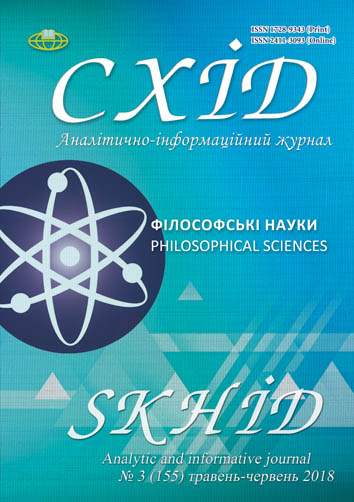Analysis of taboos as a basic principle of religious beliefs in the context of modern religious studies
DOI:
https://doi.org/10.21847/1728-9343.2018.3(155).139766Keywords:
taboo, religious beliefs, archaic and modern cultures, taboo classificationAbstract
The article analyzes some definitions of a taboo, which are well-known in modern religious studies, and looks into a taboo generation mechanism (by the example of G. R. Stephenson's experiment with rhesus monkeys). The author considers that originally a taboo is a religious phenomenon and, proceeding from the above, systematizes the areas falling under its influence. Special attention is given to a number of prohibitions related to the sacred area. It is indicated that all the spheres of life in primitive societies are regulated by sacred taboos which replace law, ethics and religion. In civilized societies taboos are represented by verbalized forms of the sacred. The author asserts that any kind of a prohibition is of absolutely religious nature by its origin and draws a conclusion that the phenomenon of taboo is a particular case of a religious prohibition both in primitive societies and modern religious traditions. The novelty of the given research is an attempt to look for ontological grounds for taboo generation in terms of religious studies.References
Anisimov, A.F. 1966. Spiritual life of primitive society. Moscow-Leningrad, 243 p. (rus).
Boroday, Yu. M. 1996. Erotica - Death - Taboo: the tragedy of human consciousness. Gnosis, Russian Phenomenological Society, Moscow, 416 р. (rus).
Guseinov, A.A. 2007. Negative ethics. (Selected lectures of the University, issue 63) Publishing house SPbGUP, Available at: https://guseinov.ru/publ/Negat_eth.html (Accessed: 05.05.2018).
Drobyshevsky, S. 2017. Remaining link. Book one: People. AST- CORPUS, Moscow, 592 p. (rus).
Girard, Rene. 2010. Violence and the sacred [Translat.] New literary review, Moscow, 448 p.
Makovsky, M.M. 2012. The phenomenon of the TABU in the traditions and in the language of the Indo-Europeans: The essence of form, development. Moscow, 280 p. (rus).
Markov, A. 2014. The evolution of man. Vol. 2. Monkeys, neurons and soul. AST Publishing, Moscow, 512 p. (rus).
Porshnev, B.F. 2006. On the beginning of human history (Problems of Paleopsychology). Fairy-V Publishing, Moscow, 640 p. (rus).
Fraser, J. 2014. Gold branch. New translations (study of magic and religion) [translat.] Academic Project, Moscow, 407 p. (rus).
Freud, S. 2008. Totem and the Taboo. Psychology of primitive culture and religion. Questions of society and the origin of religion. Firma STD Ltd, Moscow, 285-444 (rus).
Shternberg, L. 2012. Primitive religion in the light of ethnography: Studies, articles, lectures. The book house "Librocom", Moscow, 92 p. (rus).
Strong, Anise K. 2005. Incest Laws and Absent Taboos in Roman Egypt. Available at: https: //www.academia.edu/205164/ Incest_Laws_and_Absent_Taboos_in_Roman_Egypt (Accessed: 30.04.2018).
Maestripieri, Dario, 2012. What Monkeys Can Teach Us About Human Behavior: From Facts to Fiction. Available at: https://www.psychologytoday.com/intl/blog/games-primates-play/201203/what-monkeys-can-teach-us-about-human-behavior-facts-fiction (Accessed: 05.04.2018).
Encyclopaedia Britannica. Taboo Available at: https://www.britannica.com/topic/taboo-sociology (Accessed: 25.04.2018).
Stephenson, G. R. 1967. Cultural acquisition of a specific learned response among rhesus monkeys. In: Starek, D., Schneider, R., and Kuhn, H. J. (eds.), Progress in Primatology, Stuttgart: Fischer, pp. 279-288.
Wagner, Roy. 2005. Taboo. In: Jones Lindsay [editor in chief]. Encyclopedia of religion (2nd ed.). Macmillan ReferenceUSA. Thomson Gale: 8947-8949.
Webster, Hutton. 1942. Taboo: A Sociological Study. Stanford, Calif., 393 p.
Downloads
Published
How to Cite
Issue
Section
License
Copyright (c) 2018 Serhiy Titov

This work is licensed under a Creative Commons Attribution-NonCommercial-NoDerivatives 4.0 International License.
1. Authors bear responsibility for the accuracy of facts, quotations, numbers and names used.
2. Manuscripts are not sent back.
3. The publisher does not always agree with the authors' opinion.
4. The authors reserve the right to authorship of the work and pass the first publication right of this work to the journal under the terms of a Creative Commons Attribution Non-Commercial License, which allows others to freely distribute the published research with the obligatory reference to the authors of the original work and the first publication of the work in this journal.
5. The authors have the right to conclude separate supplement agreements that relate to non-exclusive work distribution in the form in which it has been published by the journal (for example, to upload the work to the online storage of the journal or publish it as part of a monograph), provided that the reference to the first publication of the work in this journal is included.

